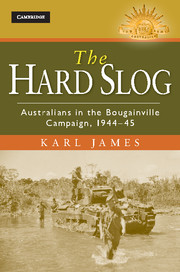Book contents
- Frontmatter
- Contents
- Maps
- Illustrations
- Abbreviations
- Acknowledgements
- Introduction
- Chapter 1 The unnecessary war
- Chapter 2 Torokina and the Outer Islands
- Chapter 3 The Central Sector
- Chapter 4 The Northern Sector
- Chapter 5 The Southern Sector
- Chapter 6 Slater's Knoll
- Chapter 7 To Buin
- Chapter 8 Peace
- Conclusion
- Notes
- Bibliography
- Index
Chapter 2 - Torokina and the Outer Islands
Published online by Cambridge University Press: 05 July 2014
- Frontmatter
- Contents
- Maps
- Illustrations
- Abbreviations
- Acknowledgements
- Introduction
- Chapter 1 The unnecessary war
- Chapter 2 Torokina and the Outer Islands
- Chapter 3 The Central Sector
- Chapter 4 The Northern Sector
- Chapter 5 The Southern Sector
- Chapter 6 Slater's Knoll
- Chapter 7 To Buin
- Chapter 8 Peace
- Conclusion
- Notes
- Bibliography
- Index
Summary
The troops are eager and keen to meet the enemy and make full use of their years of training.
9th Battalion war diary, 22 November 1944Following Blamey's Brisbane conference on 11 August 1944 where he outlined plans for the army's coming phase, Savige returned to Lae on 16 August and spent the next two days meeting with Major-General William Bridgeford, commanding the 3rd Division, and other New Guinea Force staff officers. Repeating Blamey's orders, Savige stated that the army's forthcoming role was protection of the US naval and air installations in the Solomons, New Britain and New Guinea and to ‘maintain limited pressure on the enemy’. II Corps would relieve the US Army's XIV Corps at Torokina on Bougainville, then move on to active defence and finally undertake future offensive operations. From the outset, Blamey and Savige were thinking of aggressive action.
On 20 August, in the first of a series of reconnaissance trips, Savige with Brigadiers Garrett and Pulver flew to Torokina to discuss the Australian take-over with the American corps commander, Major-General Oscar Griswold, who was described as a ‘calm, slow-speaking officer of basic simplicity and Spartan habits’. His corps of 62000 men, consisting of the 37th Infantry and the Americal Divisions, had been on Bougainville since December 1943 when it had relieved the 3rd Marine Division, which had landed at Cape Torokina the previous month. Savige spent two days at Torokina, where Griswold showed him around the base, before going on to tour Treasury Island and returning to Lae on 24 August.
- Type
- Chapter
- Information
- The Hard SlogAustralians in the Bougainville Campaign, 1944–45, pp. 29 - 70Publisher: Cambridge University PressPrint publication year: 2012



